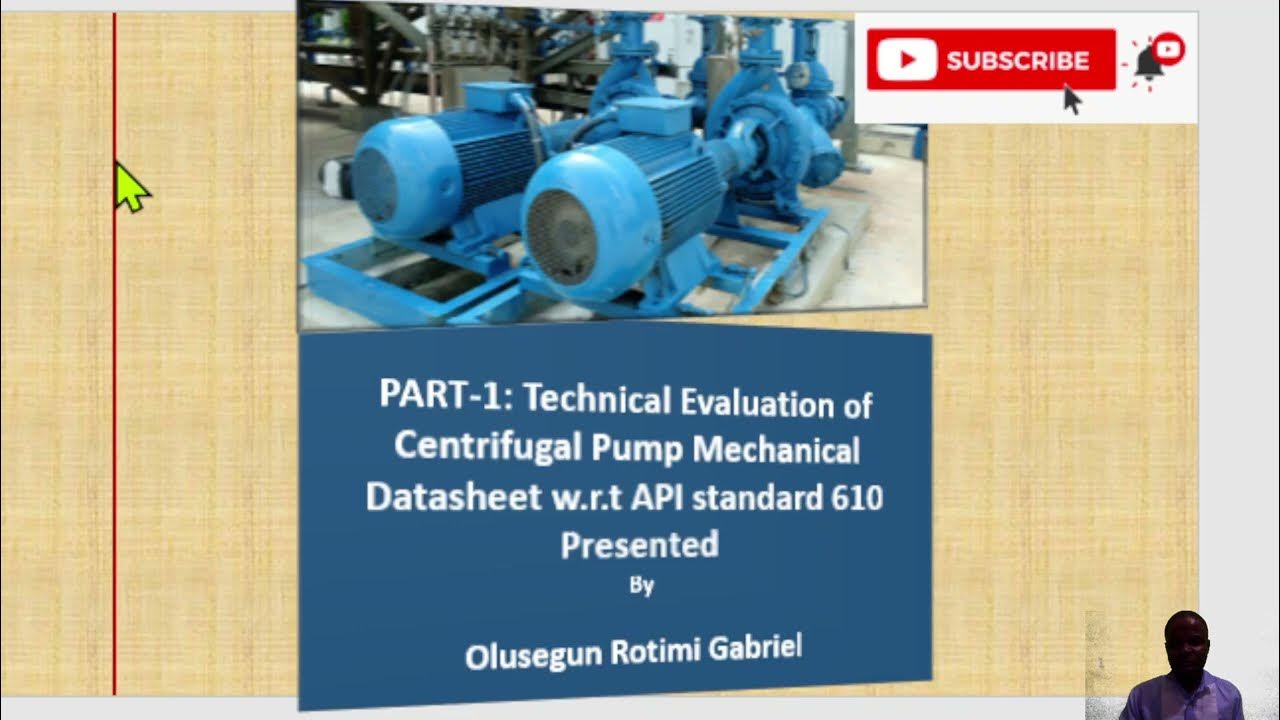pump cavitation and net positive suction head
Summary
TLDRIn this video, we explore the crucial concept of Net Positive Suction Head (NPSH) for pumps, emphasizing its importance in preventing cavitation. The video explains how NPSH ensures that the pump inlet maintains sufficient pressure to avoid vapor formation. Viewers will learn how to calculate NPSH Available and understand how to determine NPSH Required (NPSH3) through testing methods. Additionally, the NPSH Margin Ratio, which ensures efficient pump operation, is discussed. This video provides essential insights for anyone working with pumps, helping to avoid cavitation and ensure optimal performance.
Takeaways
- 😀 NPSH (Net Positive Suction Head) is the liquid energy above the vapor pressure at the pump inlet, essential for avoiding cavitation.
- 😀 Cavitation occurs when the pressure at the pump inlet drops below the vapor pressure, causing fluid to vaporize and form bubbles that can damage the pump.
- 😀 A pump requires a minimum absolute pressure at the inlet to prevent cavitation, which is referred to as NPSH available.
- 😀 To calculate NPSH available, the pressure head, atmospheric pressure head, and velocity head at the pump inlet are added together.
- 😀 NPSH required, or NPSH3, is determined through testing by throttling the suction valve and recording the total head at which the head drops by 3%.
- 😀 The constant flow method is used to determine NPSH required, where the pump’s flow is kept constant, but the suction valve is throttled.
- 😀 The NPSH margin ratio is the ratio of NPSH available to NPSH required, typically ranging from 1.1 to 1.5.
- 😀 The NPSH margin ratio depends on various factors such as the type of pump and its application.
- 😀 If the NPSH available drops below vapor pressure during operation, it can lead to excessive noise, vibration, and pump damage due to cavitation.
- 😀 Understanding and managing NPSH is crucial for the safe and efficient operation of pumps in fluid systems.
Q & A
What is Net Positive Suction Head (NPSH) and why is it important for pumps?
-NPSH is the liquid energy above the vapor pressure at the pump inlet. It is crucial for avoiding cavitation, which can cause damage to the pump, such as erosion and noise due to collapsing vapor bubbles.
What happens if the pressure at the pump inlet drops below vapor pressure?
-If the pressure at the pump inlet drops below the vapor pressure, cavitation occurs. This results in the formation of vapor bubbles, which collapse when the pressure increases, causing damage to the pump impeller and casing.
How is NPSH available (NPSHA) calculated?
-NPSHA is calculated by considering the pressure due to the water column height, the atmospheric pressure acting on the water's free surface, and the velocity head of the fluid. These are added together to determine the absolute head at the pump inlet, from which vapor pressure is subtracted.
What is the constant flow method used to determine NPSH required (NPSHR)?
-The constant flow method involves keeping the pump discharge valve fixed to maintain constant flow while throttling the suction valve. The frictional losses in the suction pipe increase, reducing the NPSHA. The test is repeated until the total developed head drops by 3%, and the NPSHR is determined.
What is cavitation, and how does it affect pumps?
-Cavitation is the formation of vapor bubbles when the pressure falls below the vapor pressure at the pump inlet. When these bubbles collapse in higher-pressure areas, they create noise, vibration, and can damage the pump impeller and casing.
How does the height of the water column at the pump inlet affect NPSHA?
-The height of the water column at the pump inlet creates pressure head, contributing to the overall NPSHA. The higher the water column, the higher the pressure at the pump inlet, which helps prevent cavitation.
What is the role of velocity head in determining NPSHA?
-Velocity head represents the kinetic energy of the water due to its velocity as it enters the pump. This contributes to the overall NPSHA, ensuring that the pump inlet pressure is above the vapor pressure to avoid cavitation.
What are the typical values of the NPSH margin ratio?
-The NPSH margin ratio typically ranges from 1.1 to 1.5. This margin ensures that there is a sufficient buffer between the NPSHA and NPSHR to avoid cavitation under varying operational conditions.
How does throttling the suction valve affect the NPSHA?
-Throttling the suction valve increases frictional losses in the suction pipe, which reduces the NPSHA. As a result, the pump becomes more susceptible to cavitation unless proper NPSH is maintained.
Why is it necessary to keep the NPSHA higher than the vapor pressure?
-Keeping NPSHA higher than the vapor pressure ensures that the fluid does not vaporize at the pump inlet. If NPSHA is lower than the vapor pressure, cavitation occurs, which can damage the pump and decrease its efficiency.
Outlines

Esta sección está disponible solo para usuarios con suscripción. Por favor, mejora tu plan para acceder a esta parte.
Mejorar ahoraMindmap

Esta sección está disponible solo para usuarios con suscripción. Por favor, mejora tu plan para acceder a esta parte.
Mejorar ahoraKeywords

Esta sección está disponible solo para usuarios con suscripción. Por favor, mejora tu plan para acceder a esta parte.
Mejorar ahoraHighlights

Esta sección está disponible solo para usuarios con suscripción. Por favor, mejora tu plan para acceder a esta parte.
Mejorar ahoraTranscripts

Esta sección está disponible solo para usuarios con suscripción. Por favor, mejora tu plan para acceder a esta parte.
Mejorar ahoraVer Más Videos Relacionados

Centrifugal Pump Basics - How centrifugal pumps work working principle hvacr

Pump Performance Curve Explained | Master the Pump Curve for Optimal Results | Pump Curve

PART-1: Technical Evaluation of Centrifugal Pump Mechanical Datasheet with respect to API 610

Pump Chart Basics Explained - Pump curve HVACR

I POMPA AIR PART 2

Car engine cooling system
5.0 / 5 (0 votes)
